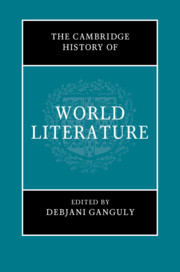Book contents
- The Cambridge History of World Literature
- The Cambridge History of World Literature
- Copyright page
- Contents
- Figures
- Contributors
- Acknowledgements
- Introduction
- Part I Genealogies
- Part II Thinking the World
- Part III Transregional Worlding
- 14 East Asia as Comparative Paradigm
- 15 Latin American Baroque: Or Error by Design
- 16 Comparative World Literature and Worlds in Portuguese
- 17 Africa and World Literature
- 18 Literary Revolution: Ireland and the World
- 19 Korean Worlds and Echoes from the Cold War
- 20 French Colonial Literature in Indochina: Colonial Adventure and Continental Drift
- 21 From Diasporic Tamil Literature to Global Tamil Literature
- Part IV Cartographic Shifts
- Part V World Literature and Translation
- Part VI Poetics, Genre, Intermediality
- Part VII Scales, Polysystems, Canons
- Part VIII Modes of Reading and Circulation
- Part IX The Worldly and the Planetary
- Index
- References
18 - Literary Revolution: Ireland and the World
from Part III - Transregional Worlding
Published online by Cambridge University Press: 17 August 2021
- The Cambridge History of World Literature
- The Cambridge History of World Literature
- Copyright page
- Contents
- Figures
- Contributors
- Acknowledgements
- Introduction
- Part I Genealogies
- Part II Thinking the World
- Part III Transregional Worlding
- 14 East Asia as Comparative Paradigm
- 15 Latin American Baroque: Or Error by Design
- 16 Comparative World Literature and Worlds in Portuguese
- 17 Africa and World Literature
- 18 Literary Revolution: Ireland and the World
- 19 Korean Worlds and Echoes from the Cold War
- 20 French Colonial Literature in Indochina: Colonial Adventure and Continental Drift
- 21 From Diasporic Tamil Literature to Global Tamil Literature
- Part IV Cartographic Shifts
- Part V World Literature and Translation
- Part VI Poetics, Genre, Intermediality
- Part VII Scales, Polysystems, Canons
- Part VIII Modes of Reading and Circulation
- Part IX The Worldly and the Planetary
- Index
- References
Summary
The 1999 publication of Pascale Casanova’s The World Republic of Letters (translation, 2004) accorded Ireland and Irish writers an unusually high profile among world literature studies. In chapter 10 of that volume, entitled “The Irish Paradigm,” Casanova foregrounded the achievement of the Irish Literary Revival as what she termed “a compact history of the revolt against the literary order.” This chapter examines the value and limitations of Casanova’s reading as part of a broader examination of the pertinence of terms such as “national,” “international” and “transnational” with respect to Irish writing. It focuses on three case studies: firstly, the historical relationship between Irish fiction and the subject of empire, as exemplified by the work of nineteenth-century novelist Maria Edgeworth. Secondly, it examines the work of W.B. Yeats, most famous writer of the Irish Revival, and his critical status as poet of decolonization and exemplar of transnational poetics. Finally, the transnational character of contemporary Irish fiction is discussed, including recent writings by writers Colm Tóibín, Anne Enright, Mike McCormack and Melatu Uche Okorie.
- Type
- Chapter
- Information
- The Cambridge History of World Literature , pp. 343 - 359Publisher: Cambridge University PressPrint publication year: 2021



